Featured image credit: SpaceX
Lift Off Time | February 12, 2023 – 05:10 UTC | 00:10 EST |
|---|---|
Mission Name | Starlink Group 5-4; the 4th Starlink Group 5 launch |
Launch Provider | SpaceX |
Customer | SpaceX |
Rocket | Falcon 9 Block 5 B1062-12; 45.82-day turnaround |
Launch Location | Space Launch Complex 40 (SLC-40), Cape Canaveral Space Force Station, Florida, USA; 5 days, 03 hours, 38 minutes turnaround |
Payload mass | ~16,900 kg (~37,200 lb) (55 x ~307 kg, plus dispenser) |
Where did the satellites go? | 530 km circular low-Earth orbit (LEO) at 43°; initial orbit 298 x 339 km at 43.00º |
Ddi they attempt to recover the first stage? | Yes |
Where did the first stage land? | ~660 km downrange on A Shortfall of Gravitas Tug: Doug; Support: Doug |
Did they attempt to recover the fairings? | The fairing halves will be recovered from the water ~660 km downrange by Doug |
Were these fairings new? | No, one fairing half flew for its eighth-time |
This was the: | – Fastest SpaceX pad turnaround time – Most flights of a fairing half (8) – 203rd Falcon 9 launch – 138th Falcon 9 flight with a flight-proven booster – 144th re-flight of a booster – 10th re-flight of a booster in 2023 – 171st booster landing – 97th consecutive landing (a record) – 10th launch for SpaceX in 2023 – 113th SpaceX launch from SLC-40 – 22nd orbital launch attempt of 2023 |
Where to watch | Official Replay |
How Did It Go?
SpaceX’s Starlink Group 5-4 mission successfully launched 55 Starlink satellites atop a Falcon 9 rocket. The Falcon 9 lifted off from Space Launch Complex 40 (SLC-40), at the Cape Canaveral Space Force Station, in Florida, United States. Starlink Group 5-4 marked the 71st operational Starlink mission and is thought to be a test mission for the evolution of this constellation’s spacecraft: Starlink gen 2. Because of this, and despite the name, the satellites were not put into the previously filled Starlink Shell 5 — a polar low-Earth circular orbit at 560 km. Instead, the satellites were inserted into a 43-degree orbit at 530 km.
As mentioned, Starlink Group 5-4 will test new hardware, involving technologies from SpaceX’s recently acquired internet of things (IoT) company SWARM. It is unknown how these technologies are being tested.
These test satellites will pave the way for SpaceX to begin proper Starlink v2 launches, which are scheduled to start in early 2023 on Starlink Group 6-1. Until SpaceX’s Starship launch vehicle is operational, these missions will utilize the Starlink v2 mini satellites.
Starlink Group 5-4 boosted the total number of Starlink satellites launched to 3,930, of which ~3,638 are still in orbit around the Earth. Starlink Group 5-4 marked the fourth launch of Group 5 satellites.
What Is Starlink?
Starlink is SpaceX’s internet communication satellite constellation. The low-Earth orbit constellation delivers fast, low-latency internet service to locations where ground-based internet is unreliable, unavailable, or expensive. The first phase of the constellation consists of five orbital shells.
Starlink is currently available in certain regions, allowing anyone in approved regions to order or preorder. After 28 launches SpaceX achieved near-global coverage, but version 1 of the constellation will not be complete until all five shells are filled. Once Starlink generations 1 and 2 are complete, the venture is expected to profit $30-50 billion annually. This profit will largely finance SpaceX’s ambitious Starship program, as well as Mars Base Alpha.

What Is The Starlink Satellite?
Each Starlink v1.5 satellite has a compact design and a mass of 307 kg. SpaceX developed a flat-panel design, allowing them to fit as many satellites as possible into the Falcon 9’s 5.2 meter wide payload fairing. Due to this flat design, SpaceX is able to fit up to 60 Starlink satellites and the payload dispenser into the second stage, while still being able to recover the first stage. This is near the recoverable payload capacity of the Falcon 9 to LEO, around 16 tonnes.
As small as each Starlink satellite is, each one is packed with high-tech communication and cost-saving technology. Each Starlink satellite is equipped with four phased array antennas, for high bandwidth and low-latency communication, and two parabolic antennas. The satellites also include a star tracker, which provides the satellite with attitude data, ensuring precision in broadband communication.
Each Starlink v1.5 satellite is also equipped with an inter-satellite laser communication system. This allows each satellite to communicate directly with other satellites, not having to go through ground stations. This reduces the number of ground stations needed, allowing coverage of the entire Earth’s surface, including the poles.
The Starlink satellites are also equipped with an autonomous collision avoidance system, which utilizes the US Department of Defense (DOD) debris tracking database to autonomously avoid collisions with other spacecraft and space junk.
To decrease costs, each satellite has a single solar panel, which simplifies the manufacturing process. To further cut costs, Starlink’s propulsion system, an ion thruster, uses krypton as fuel, instead of xenon. While the specific impulse (ISP) of krypton is significantly lower than xenon’s, it is far cheaper, which further decreases the satellite’s manufacturing cost.
Starlink v2 and v2 Mini
SpaceX’s Starlink v2 satellites are larger, more powerful satellites meant to be launched on SpaceX’s Starship launch vehicle. While little is known about these satellites thus far, it is known that they mass roughly 1,200 kg and feature a twin-solar array design, to increase power delivered to the satellite. On top of this, according to SpaceX CEO and CTO Elon Musk, the satellites will have an order of magnitude more bandwidth, higher speeds, and be roughly 10x better in every way.
In the future, Starlink v2 satellites will act as cell towers, providing worldwide cell phone coverage to T-Mobile customers. Musk has stated that each of these satellites will have roughly 2-4 Mb/s of bandwidth per cell phone zone, which will allow for tens of thousands of SMS text messages per second or many users placing phone calls. While this technology is primarily meant for contacting emergency services worldwide (similar to Apple’s connect to satellite feature on the iPhone 14 series), it will also be able to be used for sending non-emergency-related messages.
Due to delays in the Starship launch vehicle, SpaceX is preparing (and has filed for permission) to launch Starlink v2 “mini” satellites that will launch on the Falcon 9 rocket. The specs of these satellites are currently unknown.
Ion Power
Each Starlink satellite is equipped with the first Hall-effect krypton-powered ion thruster. This thruster is used for both ensuring the correct orbital position, as well as for orbit raising and orbit lowering. At the end of the satellite’s life, this thruster is used to deorbit the satellite.
What Is The Starlink Satellite Constellation?
A satellite constellation is a group of satellites that work in conjunction for a common purpose. SpaceX’s Starlink constellation consists of two generations: the first (which is largely complete) is filled with Starlink v1/1.5 satellites and the second is to be filled with Starlink v2 and v2 mini satellites.
Starlink generation one consists of five orbital shells and has a total of 4,408 satellite slots. These satellites will entirely be launched on Falcon 9, and it is expected for these launches to finish in 2023.
Generation two consists of 29,988 satellites–this is roughly 20 times more satellites than were ever launched before the start of Starlink in 2019. These satellites will primarily be launched by Starship; however, as previously mentioned, Falcon 9 will launch some of these satellites while Starship is not operational.
Due to the vast number of Starlink satellites, many astronomers are concerned about their effect on the night sky. However, SpaceX is working with the astronomy community and implementing changes to the satellites to make them harder to see from the ground and less obtrusive to the night sky. SpaceX has changed how the satellites raise their orbits and, starting on Starlink v1.0 L9, added a sunshade to reduce light reflectivity. These changes have already significantly decreased the effect of Starlink on the night sky.
Starlink Phase 1 Orbital Shells:
| Inclination (°) | Orbital Altitude (km) | Number of Satellites | |
| Shell 1 | 53.0 | 550 | 1,584 |
| Shell 2 | 70.0 | 570 | 720 |
| Shell 3 | 97.6 | 560 | 348 |
| Shell 4 | 53.2 | 540 | 1,584 |
| Shell 5 | 97.6 | 560 | 172 |
Shell 1
The first orbital shell of Starlink satellites consists of 1,584 satellites in a 53.0° 550 km low-Earth orbit. Shell 1 consists of 72 orbital planes, with 22 satellites in each plane. This shell is currently near complete, with occasional satellites being replaced. The first shell provides coverage between roughly 52° and -52° latitude (~80% of the Earth’s surface), and will not feature laser links until replaced.
Shell 2
Starlink’s second shell will host 720 satellites in a 70° 570 km orbit. These satellites will significantly increase the coverage area, which will make the Starlink constellation cover around 94% of the globe. SpaceX will put 20 satellites in each of the 36 planes in the third shell. This shell is currently being filled, along with Shell 4.
Shell 3
Shell 3 will consist of 348 satellites in a 97.6° 560 km orbit. SpaceX deployed 10 laser link test satellites into this orbit on its Transporter-1 mission to test satellites in a polar orbit. SpaceX launched an additional three satellites to this shell on the Transporter-2 mission. On April 6, 2021, Gwynne Shotwell said that SpaceX will conduct regular polar Starlink launches in the summer, but this shell is now the lowest priority and is expected to be the last filled. All satellites that will be deployed into this orbit will have inter-satellite laser link communication. Shell 3 will have six orbital planes with 58 satellites in each plane.
Shell 4
The fourth shell will consist of 1,584 satellites in a 540 km 53.2° LEO. This updated orbital configuration will slightly increase coverage area and will drastically increase the bandwidth of the constellation. This shell will also consist of 72 orbital planes with 22 satellites in each plane. This shell is currently being filled alongside Shell 2.
Shell 5
The final shell of Phase 1 of Starlink will host 172 satellites in another 97.6° 560 km low-Earth polar orbit. Shell 5 will also consist purely of satellites with laser communication links; however, unlike Shell 3, it will consist of four orbital planes with 43 satellites in each plane.
However, it is unclear if this shell is still going to be filled; this launch, labeled Starlink Group 5-4, went to a 43° orbit.
Starlink Generation 2 Orbital Shells:
The Starlink gen 2 constellation consists of nine orbital shells. It is currently unclear how these shells will be named.
| Inclination (°) | Altitude (km) | Orbital Planes | Satellites per Plane | Number Of Satellites |
| 53.0 | 340 | 48 | 110 | 5,280 |
| 46.0 | 345 | 48 | 110 | 5,280 |
| 38.0 | 350 | 48 | 110 | 5,280 |
| 96.9 | 360 | 30 | 120 | 3,600 |
| 53.0 | 525 | 28 | 120 | 3,360 |
| 43.0 | 530 | 28 | 120 | 3,360 |
| 33.0 | 535 | 28 | 120 | 3,360 |
| 148.0 | 604 | 12 | 12 | 144 |
| 115.7 | 614 | 18 | 18 | 324 |
SpaceX has until March of 2024 to complete half of generation 1 and must fully complete generation 1 by March of 2027. In the highly unlikely case that SpaceX fails this goal, failure to do so could result in SpaceX losing its dedicated frequency band.
What Is Falcon 9 Block 5?
The Falcon 9 Block 5 is SpaceX’s partially reusable two-stage medium-lift launch vehicle. The vehicle consists of a reusable first stage, an expendable second stage, and, when in payload configuration, a pair of reusable fairing halves.
First Stage
The Falcon 9 first stage contains 9 Merlin 1D+ sea level engines. Each engine uses an open gas generator cycle and runs on RP-1 and liquid oxygen (LOx). Each engine produces 845 kN of thrust at sea level, with a specific impulse (ISP) of 285 seconds, and 934 kN in a vacuum with an ISP of 313 seconds. Due to the powerful nature of the engine, and the large amount of them, the Falcon 9 first stage is able to lose an engine right off the pad, or up to two later in flight, and be able to successfully place the payload into orbit.
The Merlin engines are ignited by triethylaluminum and triethylborane (TEA-TEB), which instantaneously burst into flames when mixed in the presence of oxygen. During static fire and launch the TEA-TEB is provided by the ground service equipment. However, as the Falcon 9 first stage is able to propulsively land, three of the Merlin engines (E1, E5, and E9) contain TEA-TEB canisters to relight for the boost back, reentry, and landing burns.
Second Stage
The Falcon 9 second stage is the only expendable part of the Falcon 9. It contains a singular MVacD engine that produces 992 kN of thrust and an ISP of 348 seconds. The second stage is capable of doing several burns, allowing the Falcon 9 to put payloads in several different orbits.
For missions with many burns and/or long coasts between burns, the second stage is able to be equipped with a mission extension package. When the second stage has this package it has a grey strip, which helps keep the RP-1 warm, an increased number of composite-overwrapped pressure vessels (COPVs) for pressurization control, and additional TEA-TEB.
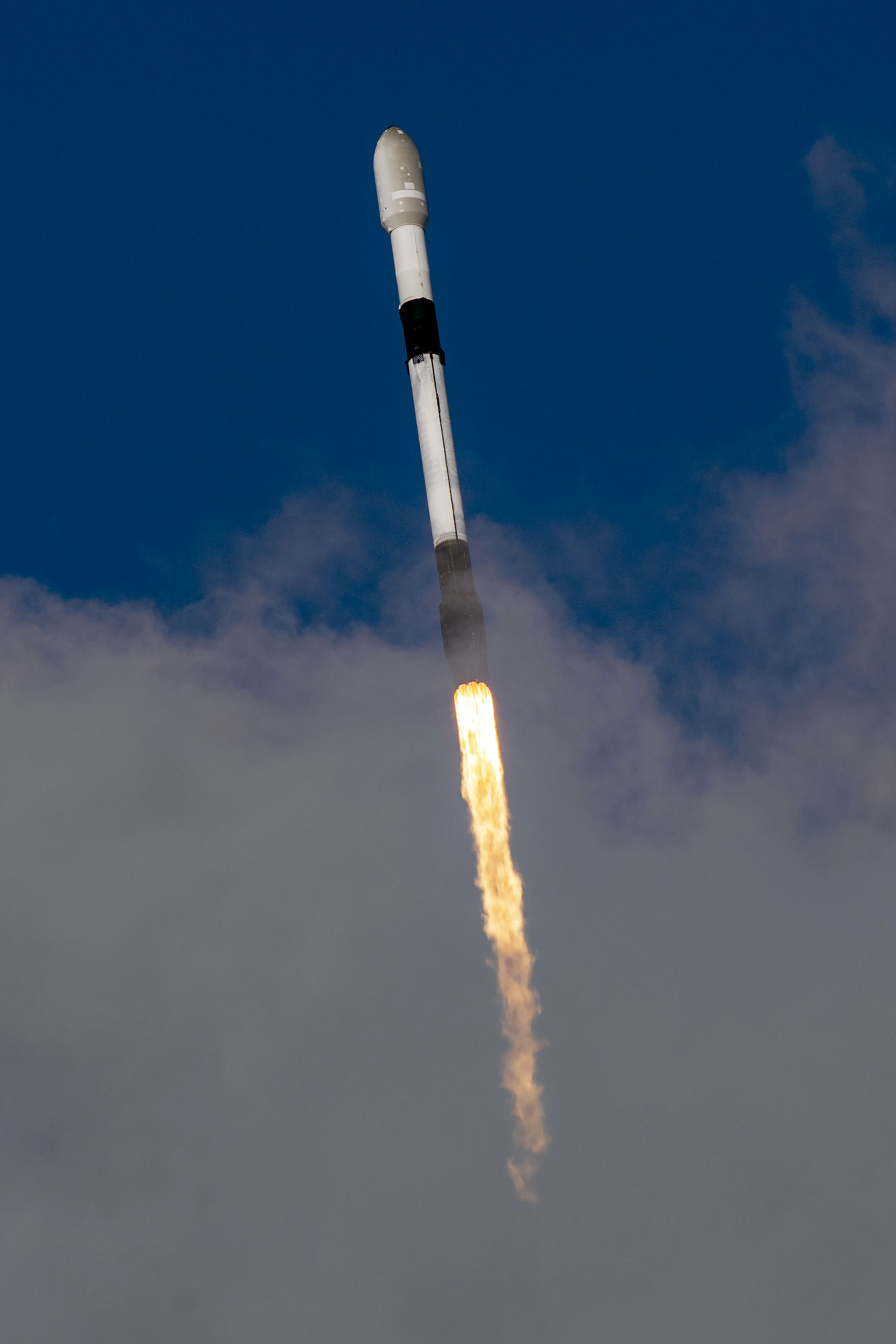
Falcon 9 Booster
The booster that supported the Starlink Group 5-4 mission is B1062-12; as the name implies, the booster had flown 11 previous times. This changed to B1062-13 upon successful landing.
| B1062’s missions | Launch Date (UTC) | Turnaround Time (Days) |
| GPS Block III SV04 | November 5, 2020 23:24 | N/A |
| GPS Block III SV05 | June 17, 2021 16:09 | 223.70 |
| Inspiration4 | September 16, 2021 0:02 | 90.33 |
| Starlink Group 4-5 | January 6, 2022 21:49 | 112.91 |
| Ax-1 | April 8, 2022 15:17 | 91.73 |
| Starlink Group 4-16 | April 29, 2022 21:27 | 21.26 |
| Nilesat-301 | June 8, 2022 21:04 | 39.98 |
| Starlink Group 4-25 | July 24, 2022 13:38 | 45.69 |
| Starlink Group 4-27 | August 19, 2022 19:21 | 26.24 |
| Starlink Group 4-36 | October 20, 2022 14:50 | 61.81 |
| Starlink Group 5-1 | December 28, 2022 09:34 | 68.78 |
| Starlink Group 5-4 | February 12, 2023 05:10 | 45.82 |
Following stage separation, the Falcon 9 conducted two burns. These burns softly touched down the booster on SpaceX’s autonomous spaceport drone ship A Shortfall of Gravitas.
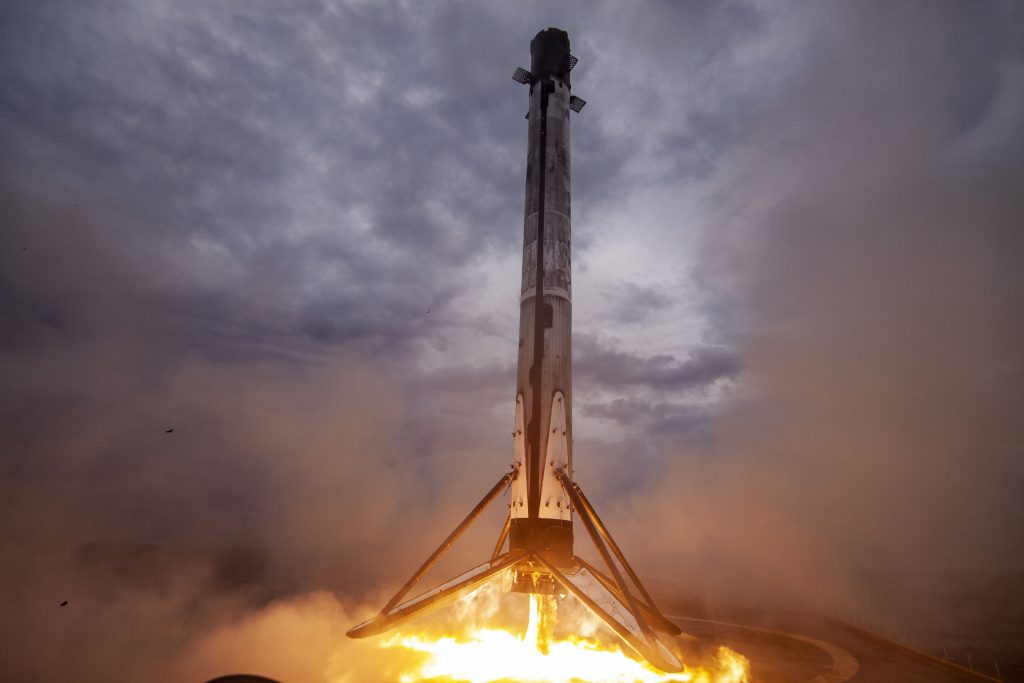
Falcon 9 Fairings
The Falcon 9’s fairing consists of two dissimilar reusable halves. The first half (the half that faces away from the transport erector) is called the active half, and houses the pneumatics for the separation system. The other fairing half is called the passive half. As the name implies, this half plays a purely passive role in the fairing separation process, as it relies on the pneumatics from the active half.
Both fairing halves are equipped with cold gas thrusters and a parafoil which are used to softly touch down the fairing half in the ocean. SpaceX used to attempt to catch the fairing halves, however, at the end of 2020 this program was canceled due to safety risks and a low success rate. On Starlink Group 5-4, SpaceX attempted to recover the fairing halves from the water with their recovery vessel Doug.
In 2021, SpaceX started flying a new version of the Falcon 9 fairing. The new “upgraded” version has vents only at the top of each fairing half, by the gap between the halves, whereas the old version had vents placed spread equidistantly around the base of the fairing. Moving the vents decreases the chance of water getting into the fairing, making the chance of a successful scoop significantly higher.
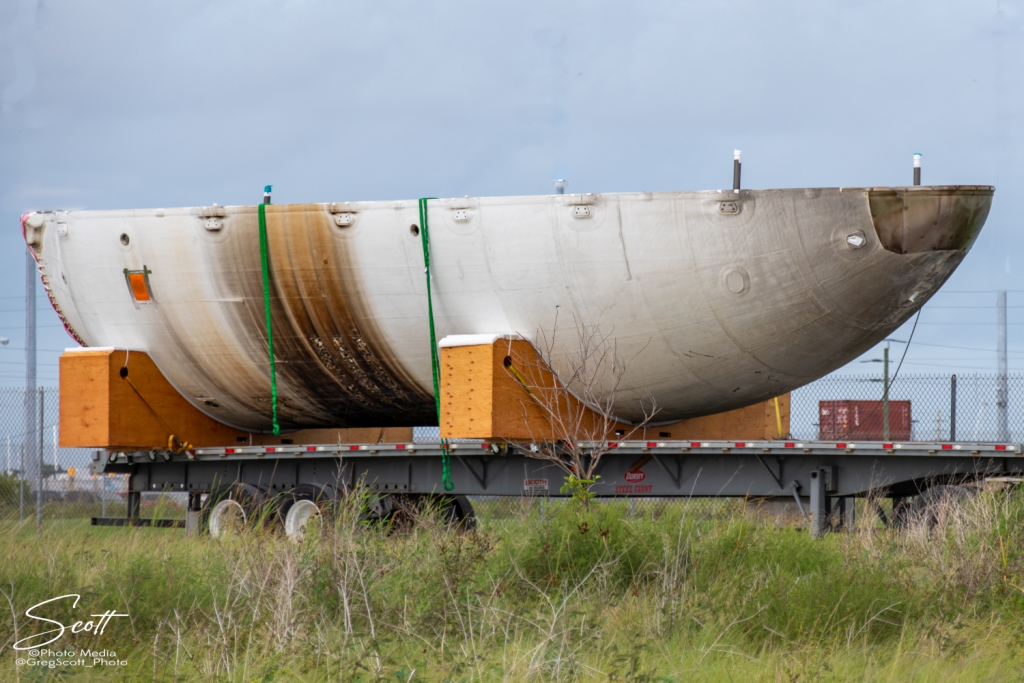

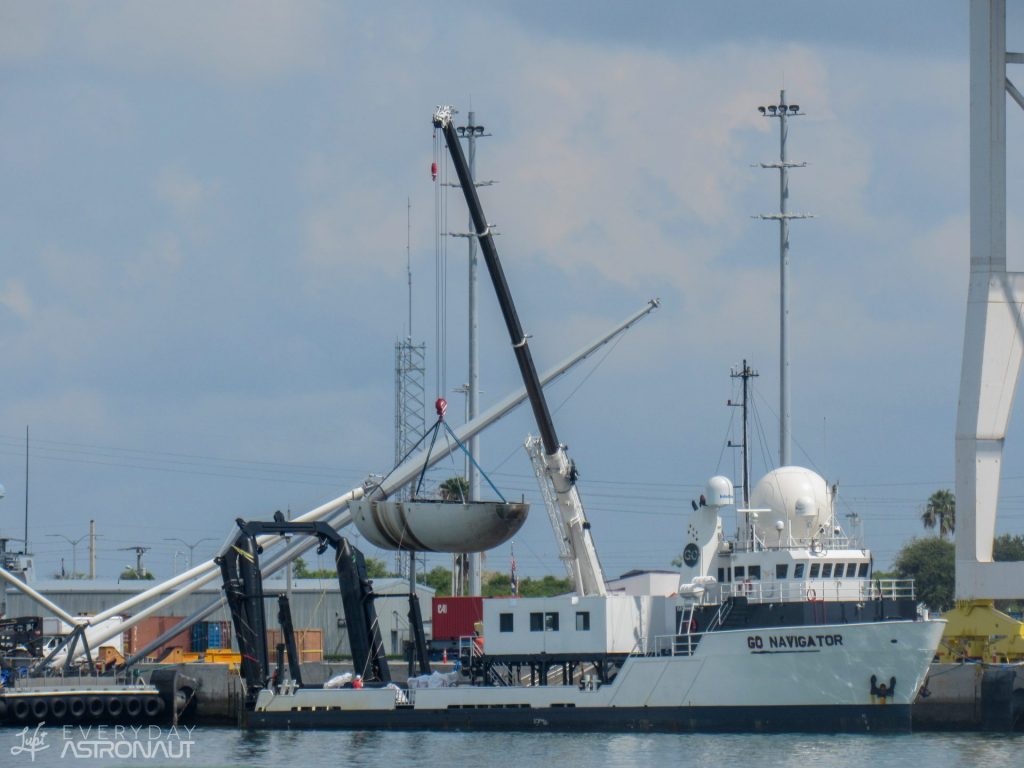
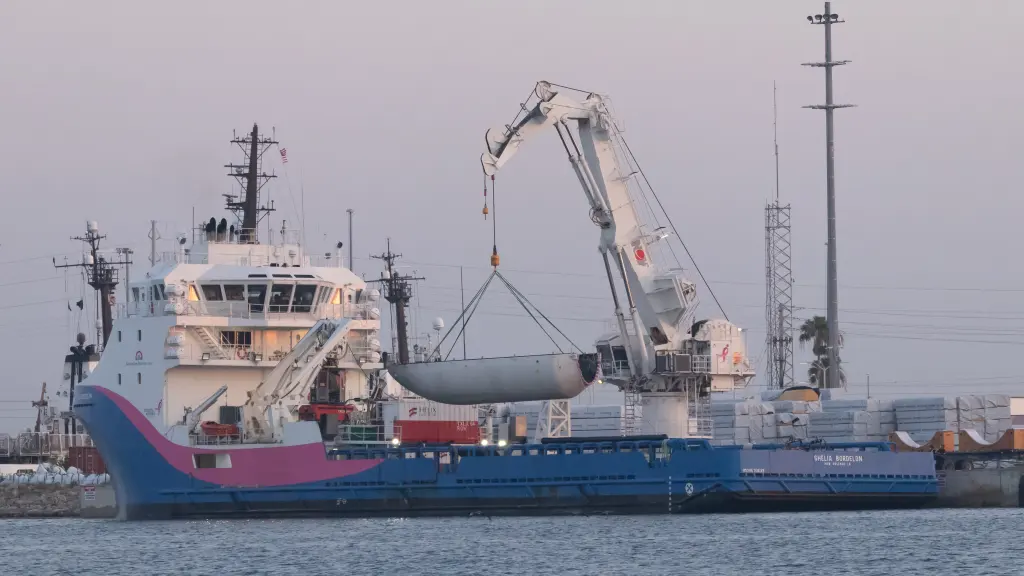
Starlink Group 5-4 Countdown
All times are approximate
| HR/MIN/SEC | EVENT |
|---|---|
| 00:38:00 | SpaceX Launch Director verifies go for propellant load |
| 00:35:00 | RP-1 (rocket grade kerosene) loading underway |
| 00:35:00 | 1st stage LOX (liquid oxygen) loading underway |
| 00:16:00 | 2nd stage LOX loading underway |
| 00:07:00 | Falcon 9 begins engine chill prior to launch |
| 00:01:00 | Command flight computer to begin final prelaunch checks |
| 00:01:00 | Propellant tank pressurization to flight pressure begins |
| 00:00:45 | SpaceX Launch Director verifies go for launch |
| 00:00:03 | Engine controller commands engine ignition sequence to start |
| 00:00:00 | Falcon 9 liftoff |
Starlink Group 5-4 Launch, Landing, And Deployment
All Times Approximate
| HR/MIN/SEC | EVENT |
|---|---|
| 00:01:12 | Max Q (moment of peak mechanical stress on the rocket) |
| 00:02:28 | 1st stage main engine cutoff (MECO) |
| 00:02:31 | 1st and 2nd stages separate |
| 00:02:38 | 2nd stage engine starts (SES-1) |
| 00:02:45 | Fairing deployment |
| 00:06:17 | 1st stage entry burn begins |
| 00:06:35 | 1st stage entry burn ends |
| 00:08:12 | 1st stage landing burn begins |
| 00:08:32 | 1st stage landing |
| 00:08:39 | 2nd stage engine cutoff (SECO-1) |
| 00:54:12 | 2nd stage engine starts (SES-2) |
| 00:54:14 | 2nd stage engine cutoff (SECO-2) |
| 01:03:15 | Starlink satellites deploy |





